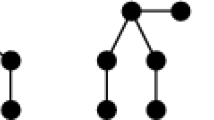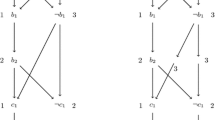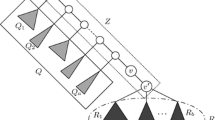Abstract
A computer algorithm is presented which equiprobably generates any member of the set of all directed trees withk labeled terminal nodes and unlabeled interior nodes. The algorithm requires roughlyk 2/2 storage locations. The one-time initialization requiresO(k 2) time, while generating each tree requiresO(k) time.
Similar content being viewed by others
Literature
Edwards, A. W. F. and L. L. Cavalli-Sforza. 1964. “Reconstruction of Evolutionary Trees.” InPhenetic and Phylogenetic Classification, Eds. W. H. Heywood and J. McNeill, Systematics Association Publication Number 6, pp. 67–76. London.
Felsenstein, J. 1978. “The Number of Evolutionary Trees.”Syst. Zool. 27, 27–33.
Foulds, L. R. and R. W. Robinson. 1981.Enumeration of Binary Phylogenetic Trees, Lecture Notes in Mathematics, No. 884. pp. 173–186. New York: Springer-Verlag.
Knuth, D. E. 1973.The Art of Computer Programming. Vol. 1, 2nd Edn. Reading, MA: Addison-Wesley.
Knott, G. D. 1977. “A Numbering System for Binary Trees.”Communs Ass. comput. Mach. 20, 113–115.
Leclerc, B. 1982.Description, Evaluation et Comparison des Hierarchies de Parties. Paris: Centre d'Analyse et de Mathematique Sociale.
Mickevich, M. F. 1978. “Taxonomic Congurence.”Syst. Zool. 27, 143–158.
Nijenhuis, A. and H. S. Wif. 1975. “Combinatorial Algorithms.” InComputer Science and Applied Mathematics, Ed. W. Rheinboldt, Ch. 24–25. New York: Academic Press.
Penny, D., L. R. Fould and M. D. Hendy 1982. “Testing the Theory of Evolution by Comparing Phylogenetic Trees Constructed from Five Different Protein Sequences.”Nature 297, 197–200.
Proskurowski, A. 1980. “On the Generation of Binary Trees.”J. Ass. comput. Mach. 27, 1–2.
Rohlf, F. J. 1983. “Numbering Binary Trees with Labelled Terminal Vertices.”Bull. math. Biol. 45, 33–40.
Schuh, R. J. and F. J. Farris 1981. “Methods for Investigating Taxonomic Congruence and their Application to the Leptopodomorpha.”Syst. Zool. 30, 331–350.
Shao, K. and F. J. Rohlf. 1983. “Sampling Distribution of Consensus Indices when all Bifurcating Trees are Equally Likely.” InNumerical Taxonomy. Proceedings of the NATO Advanced Study Institute, Ed. J. Felsenstein, pp. 132–137. NATO Advanced Study Institute Series G (Ecological Science), No. 1. New York: Springer-Verlag.
Sokal, R. R. and F. J. Rohlf. 1981. “Taxonomic Congruence in the Leptopodomorpha Re-examined.”Syst. Zool. 30, 309–325.
Solomon, M. and R. A. Finkel. 1980. “A Note on Enumerating Binary Trees.”J. Ass. comput. Mach. 27, 3–5.
Author information
Authors and Affiliations
Additional information
Contribution No. 477 in Ecology and Evolution, State University of New York at Stony Brook. This research was supported by Grant No. DEB8003508 from the National Science Foundation to Robert R. Sokal.
Rights and permissions
About this article
Cite this article
Oden, N.L., Shao, KT. An algorithm to equiprobably generate all directed trees withk labeled terminal nodes and unlabeled interior nodes. Bltn Mathcal Biology 46, 379–387 (1984). https://doi.org/10.1007/BF02462013
Received:
Revised:
Issue Date:
DOI: https://doi.org/10.1007/BF02462013




